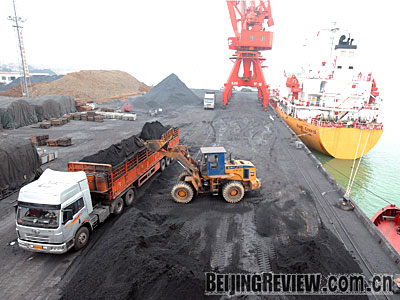| 
IN THE BLACK: Price hikes for refined oil and coal are the major factors pushing up PPI growth. In this photo, a truck at Guangxi's Qinzhou Port is preparing to transport coal (ZHANG AILIN)
The producer price index (PPI) of China has been rising rapidly, while the growth of its consumer price index (CPI) has started to fall, prompting concerns about the well-being of both industry and the economy.
During the past year, CPI growth has increased quickly and has been transferred to the PPI, prompting a similar rise. According to figures released by the National Bureau of Statistics (NBS) on September 10, the CPI increased 4.9 percent in August compared with the same period last year, representing a year-on-year growth drop for the fourth consecutive month. But the PPI grew 10.1 percent compared with the same period last year, the highest in the past 12 years.
"If PPI continues to grow while CPI keeps falling, industry will be affected, and this will inevitably cause a further deterioration of the economic downturn," said Ren Xingzhou, Director of the Institute of Market Economy of the Development Research Center of the State Council.
Impacts on economic growth
NBS figures indicate that large price hikes in refined oil, coal and raw materials are the major factors that have pushed up PPI growth. This has made it more difficult for companies operating in the manufacturing industries, which rely on low-cost competition to generate revenue.
The current situation, whereby PPI continues to increase while CPI comes down, proves that the rising costs of raw materials and labor in the industrial sector cannot be smoothly transferred to downstream manufacturing products, Ren said. It also indicates that the rising costs of industrial enterprises, especially processing enterprises, cannot be shifted, preventing companies from using their maximum production capacities, he said.
Meanwhile, in the first half of this year, the growth of disposable household income in urban areas dropped to 6.3 percent from 12.2 percent in 2007. Consumers' expectations about where the economy is headed and their willingness to purchase durables have decreased greatly compared with last year. This would slow down the sales revenue growth of enterprises and decrease their expectations of business performance, Ren said.
"It will put great pressure on the target of steady and rapid economic growth," Ren continued.
He Weijiang, a macroeconomic analyst at Central China Securities Co. Ltd., pointed out that the high PPI growth rate in August would further reduce the profits of enterprises. PPI growth reflects production, while CPI growth reflects sales. When production costs rise and sales prices drop, the profits of enterprises are continuously extruded. As companies' enthusiasm about investment wanes, they will reduce their production capacities and plans for industrial expansion, which will prompt a further slowdown in economic growth.
NBS figures also show that as PPI growth increases, industrial added value has declined. A company's added value is its output value minus costs for intangible production, such as marketing, interest, fixed assets depreciation and maintenance and repairs. In August, the added value of industrial enterprises grew 12.8 percent compared with the same period last year, the lowest since August 2002.
Pushing up the CPI?
People are concerned that the high PPI growth will force the CPI to rise.
Figures released by the NBS show that in August among ex-factory prices for industrial products, prices for capital goods rose 12 percent year on year. This could mean that prices of consumer goods such as food, clothing and daily necessities may rise in the future.
| 